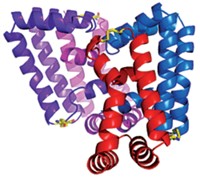Advertisement
Grab your lab coat. Let's get started
Welcome!
Welcome!
Create an account below to get 6 C&EN articles per month, receive newsletters and more - all free.
It seems this is your first time logging in online. Please enter the following information to continue.
As an ACS member you automatically get access to this site. All we need is few more details to create your reading experience.
Not you? Sign in with a different account.
Not you? Sign in with a different account.
ERROR 1
ERROR 1
ERROR 2
ERROR 2
ERROR 2
ERROR 2
ERROR 2
Password and Confirm password must match.
If you have an ACS member number, please enter it here so we can link this account to your membership. (optional)
ERROR 2
ACS values your privacy. By submitting your information, you are gaining access to C&EN and subscribing to our weekly newsletter. We use the information you provide to make your reading experience better, and we will never sell your data to third party members.
Synthesis
Bacteria Confiscate Unstable Iron-Citrate Complex
Unique protein may give Bacillus cereus a leg up in sequestering the life-essential element iron
by Jyllian Kemsley
October 8, 2012
| A version of this story appeared in
Volume 90, Issue 41
A unique bacterial protein selectively binds an unstable triferric citrate complex to import iron into Bacillus cereus cells, reports a team from the University of California, Berkeley (Proc. Natl. Acad. Sci. USA, DOI: 10.1073/pnas.1210131109). Iron is an essential element that bacteria commonly sequester by sending ligands, called siderophores, to chelate insoluble Fe3+ in the environment. Selective binding and transport proteins then convey the complexes back into the cells. Common siderophores include citrate ([COH(COO)(CH2COO)2]3–) and citrate-based ligands. Citrate’s carboxyl and hydroxyl groups coordinate Fe3+. Previously, however, citrate-binding proteins were observed harboring only Fe(citrate)2 and Fe2(citrate)2. Kenneth N. Raymond and colleagues have now identified a B. cereus protein, christened ferric citrate-binding protein C, or FctC, that selectively binds Fe3(citrate)3 even when other iron-citrate species are present in solution. Only a few closely related species have genes for similar proteins, so FctC may give the B. cereus group an advantage by enabling import of iron complexes that other bacteria cannot sequester.




Join the conversation
Contact the reporter
Submit a Letter to the Editor for publication
Engage with us on Twitter